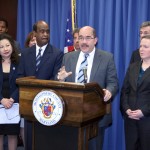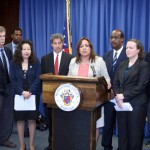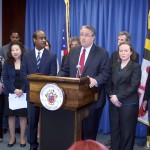
Annapolis Accomplishments (Video and Photos)
Montgomery County Executive Isiah Leggett is celebrating the accomplishments achieved by Montgomery County in Annapolis this year.
“Montgomery County’s number one priority for more than 10 years has been to obtain more transportation funding,” said Leggett on April 10. “Six years ago, I virtually stood alone in advocating for an increase in the state’s gasoline tax, which hadn’t been increased since 1992 when George Bush Sr. was President. Since then, I have testified at every hearing on this issue and have been relentless in its support.
“An increase in transportation funding is vital to helping commuters who are stuck in traffic congestion and to our ability to attract jobs and investment in the future. Thanks to our continuing efforts and the hard work and diligence of our state legislative delegation, we finally will have the sustainable funding source to help us build the transit, road, pedestrian and bike projects we so desperately need.”
Joining Leggett were Senators Jamie Raskin, Montgomery County senate delegation chair; Jennie Forehand and Brian Frosh; Delegates Anne Kaiser, Montgomery County house delegation chair; Susan Lee, Montgomery County house delegation vice chair; Charles Barkley; Al Carr; and Richard Madaleno; and. Montgomery County Councilmembers Nancy Navarro, Council president; Craig Rice, Council vice president; Marc Elrich; Nancy Floreen and George Leventhal.
Photos | Montgomery County
“This is a great moment exemplifying what “One Maryland” means,” said Navarro. “The need for more transportation funding is directly tied to the future of our economic development. Transportation funding increases were our number one priority. The gas tax sets us on a path towards a vibrant future. I’m very proud of our delegation.”
The new revenue raised by the gas tax increase is expected to raise $4.4 billion over the next six years. This funding will help support the costs of key County transit projects, including the Purple Line, the Corridor Cities Transitway and a backlog of major road projects.
“The Montgomery County delegation, the County Executive and the County Council were a model of political cohesion and determination in fighting for a major new investment in the transportation infrastructure that is so critical to our future,” said Raskin. “Everyone knows Montgomery is the engine of the Maryland economy but the engine needs a tune-up, and that means we need to address the traffic congestion that’s altering our quality of life and slowing down economic activity. The coming infusion of transportation funds will allow us all to get moving again, both on the roads and on public transit with the Purple Line. Meantime, our delegation led the efforts to pass the strongest gun safety law in America and to repeal the death penalty, so we vindicated both our priorities and our values.”
“Not only was transportation our number one priority, it was also our number two and number three priorities,” said Kaiser. “Montgomery County needs money for the Purple Line, the Corridor Cities Transitway, the Watkins Mill Interchange and a backlog of road projects. We are recognized as the economic engine of the State, and increased transportation monies are needed to keep our engine humming. I’m also proud of the funding we got for education and the progress we made on social issues.”
Leggett strongly supported other measures that passed this session, including the State’s strong gun violence law, the abolishment of the death penalty and drivers licenses for undocumented residents.
For public school construction, the County received more than $28 million. Montgomery College received nearly $6 million to complete the Germantown Campus Bioscience Education Center and to begin the Rockville Campus Science West renovation. The Universities at Shady Grove received an additional $5 million for planning and design of a fourth building on campus. This investment is critical to expanding the County’s biotech and life sciences focus. A major investment in the University of Maryland system will benefit County students by helping to keep tuition rates stable. State allocations to public education increased by $13.7 million in operating aid.
Other capital project funding of more than $7 million included housing for low income residents and those with mental health issues; Holy Cross Hospital; a number of parks; arts programs; and a variety of other projects.
Among the other services with significant increases in state operating aid are public safety, with a more than 50 percent increase; Program Open Space, increasing nearly 110 percent; libraries; and Montgomery College. About $2 million will be added for adult literacy. Money for health care was provided that will allow Maryland to open its health insurance exchange in October. An estimated 55,000 Montgomery County residents could be eligible to enroll in the federally-subsidized health plans offered through the exchange.
Economic development measures that will directly benefit Montgomery County businesses include a new cyber-security investment tax credit, greater financial commitment to the biotech tax credit and improvements to the InvestMaryland program.
Environmental initiatives approved are new laws that require the Maryland-National Capital Park and Planning Commission to construct green buildings where feasible; require the Washington Suburban Sanitary Commission to provide more notice about sewage leaks and give the County more flexibility in managing storm water and restoring streams.






Engage us on Facebook
Follow us on Twitter
Tweets by @mymcmedia